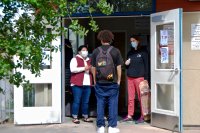In California, Some Schools Reopen for Vulnerable Students
In one county in California, alternative education and special education students are starting to return to school with new heightened health protocols.
Your content has been saved!
Go to My Saved Content.A fold-out table now blocks the entrance to Marin County’s Community School, where a staff member in a face mask stands, poised with an infrared thermometer and a container of Clorox wipes. As students arrive, she scans each child’s forehead to make sure their temperature reads no higher than 100.4, then asks four questions about their health.
“Do you or anyone you live with have close contact with anyone with a prolonged cough, fever, flulike symptoms, or with anyone who has been diagnosed with Covid-19 within the last 14 days?” she begins. Once the health and safety i’s are dotted and t’s are crossed, the student enters the building and heads to class.
This alternative high school with students in grades seventh through 12 in San Rafael, California, is one of three schools in Marin County that have recently opened their doors in the last few weeks of a tumultuous school year. At San Jose Middle School in Novato, a small class of students with special needs returned on May 18, and at nearby Marindale School, a mixed class of children of essential workers and children with special needs started May 20. All three schools serve some of the district’s “most vulnerable students,” said Superintendent Mary Jane Burke, who sees the reopenings as a pilot project to inform school protocols in the county this summer and fall.
“Though everyone was trying hard, it became very clear that for some of our students, particularly kids with learning differences or ones that really need to be engaged with caring adults, remote learning was just not working,” said Burke. “I think that was the hard part, looking in the mirror and saying to myself, ‘We cannot pretend everything's fine.’”
Getting Set Up
Influenced by the success (and stability) of local pop-up day cares opened for the children of essential workers at the start of the pandemic, Burke concluded that a similar approach could be used at some of the county’s small classes and schools for underserved students.
She and other leaders researched health protocols from the Centers for Disease Control and Prevention (CDC) and the local health department, and determined that classes kept to 12 students or fewer—with no new students or staff members entering the classroom—would be safe and operate much like a family unit that practices social distancing. These small cohorts also help isolate an infected student from the rest of the school: If a student gets sick, the cohort quarantines for two weeks, but the whole school does not have to shut down.
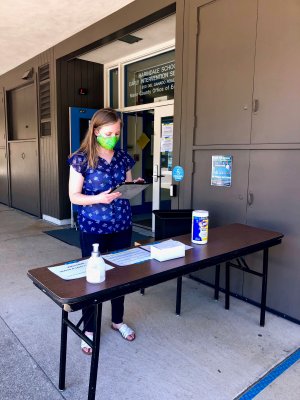
Before students returned, educators at each school also worked to restructure the classrooms, removing clutter; spacing out desks and tables six feet apart; and stocking up on disposable masks, disinfectant spray, paper towels, and hand sanitizer. When on site, all students and staff go through the same daily check-in procedure, and they are required to wear masks and regularly sanitize hands and surfaces throughout the day.
“I had a little bit of apprehension returning, just because this is brand-new—teaching in the middle of a pandemic—but I was also excited,” said Ashley Wooldridge, a pre-K teacher with the Great Expectations program at Marindale School, the only site where students are not expected to social-distance due to age. “My personal belief is that the students that we serve are best served in the classroom, around their friends and around their teachers.”
Though the class sizes and student-to-staff ratios at each site were already small, the decision to return was a brave and ambitious one, so the district offered focus groups and surveys—to both parents and teachers—to help answer questions, ease concerns, and go over protocols. A survey sent to more than 100 parents of students with special needs showed that 92 percent wanted their children to return to school.
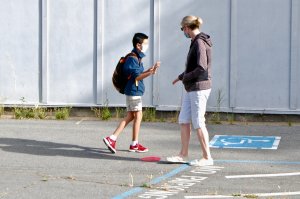
The first teacher to open her classroom was Cindy Evans, a special education teacher at San Jose Middle School, who felt her eight students were missing out on significant learning—like social skills and functional life skills development—during the closure. One parent of a student was so overwhelmed supporting her child’s learning at home that she was “distraught,” Evans shared.
“I just knew that as a teacher, I didn’t feel like I was being the teacher that I wanted to be, or that I can be, and that I should be,” said Evans, whose students’ special needs include autism, Down syndrome, and cerebral palsy. “I thought, there’s got to be a way for us to get the children back into the classroom; we just have to think outside of the box.”
Adapting Quickly
Because students with special needs often rely heavily on routine, Evans says she’s keeping a very similar structure to what she had before Covid-19 closures—with a few modifications. To keep the class isolated, the occupational therapist still “meets” with students at the same date and time, but now it’s by Zoom. The students also recently videoconferenced with their qigong instructor and some dogs from the nonprofit Jessica's Haven. While a couple of students haven’t returned in person yet due to transit and medical concerns (and are attending school virtually), the class seems excited to be back, she said.
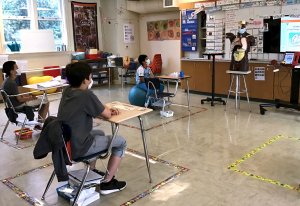
Candice Aguirre, a science teacher at Marin’s Community School, reports the same enthusiasm from her returning students, many of whom were upset that the school closed and struggled to fully engage with virtual learning. The school serves secondary school students who did not thrive in more traditional schools and greatly rely on the in-person connections with teachers and peers to motivate them, she said.
While the first day back “was a bit awkward at first,” staying six feet apart and wearing masks, everyone seems to be adjusting, said Aguirre, who feels the hardest part will be the lack of human contact—the high fives, the hugs—that played an important role at her school before Covid-19. She predicts that the fall will have a similar blend of virtual and in-person learning like the school is doing now: Each grade, seventh through 12th, attends school on a specific day; on other days, they learn from home.
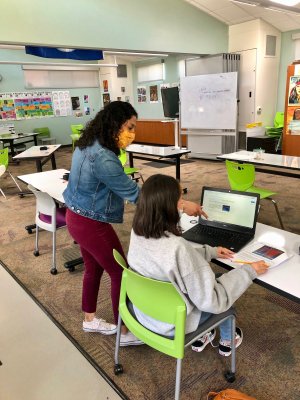
In Marin County at large, there are still a number of kinks to work out for summer and fall, such as addressing student transit and staffing at larger schools with core subject teachers, said Burke. They will also have to carefully consider how to integrate students who are medically fragile. But staff who have returned remain optimistic that their efforts will be a catalyst that helps guide the opening of more schools—and gets students and staff back where they’re supposed to be.
“When you’re an educator, you go into education for students. And if you’re trying to run a school without actually seeing students, it’s just hard,” said Katy Foster, a co-principal at Marin’s Community School. “Having the students back here has reenergized me 100 percent, and that’s what the teachers are reporting to me too. They’re just grateful and happy to see their students and engage with them again.”
